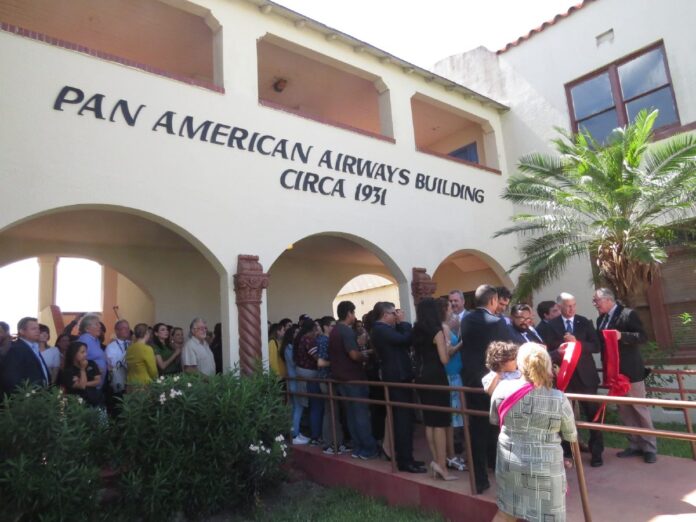It’s fitting that an entity meant to launch Brownsville into the new space age should be housed in a building from the city’s cutting-edge aviation past.
An official ribbon-cutting ceremony took place Thursday at the old Pan American Airways building at the Brownsville South Padre Island International Airport for Expanding Frontiers, a nonprofit corporation whose mission is to help the city seize opportunities presented by the burgeoning space industry.
Pan Am started operations in Brownsville in 1929, just after the city’s airport was completed, and maintained its Western Division headquarters here from 1932 to 1959. SpaceX, founded by Elon Musk in 2002, announced in 2012 that Brownsville was among several sites being considered for a commercial rocket launch site — the world’s first.
In September 2014, a ceremonial groundbreaking for the SpaceX launch site took place at Boca Chica Beach, 24 miles east of Brownsville. The company conducted two test firings of the Raptor engine on its Starhopper prototype at Boca Chica in early April, and is in the process of installing a new engine in preparation for hover tests this month.
Expanding Frontiers was created by the city in partnership with University of Texas Rio Grande Valley associate professor of physics Fredrick Jenet in order to help cultivate a private aerospace cluster centered on SpaceX, with jobs and economic development the ultimate goal. The project was recently awarded $650,000 in funding from the Brownsville Community Improvement Corporation.
The first Expanding Frontiers effort, a partnership with the Brownsville Independent School District dubbed the “Summer Entrepreneur Summer Academy,” got underway on July 8.
City Manager Noel Bernal, who spoke at Thursday’s ceremony, noted that so far Expanding Frontiers has been the beneficiary of $1 million in seed money between BCIC and BISD. The reason for such investments isn’t because space is exciting but because Brownsville stands to gain economically if it can attract and foster new-space entrepreneurism.
“Why are we doing this? Investment banking firm Morgan Stanley estimates that the global space industry or space economy … could generate more than $1 trillion by 2040, up from the current $350 billion,” he said. “That’s a lot.”
Sean Casey, cofounder and managing director of the Silicon Valley Space Center, a business accelerator for new-space entrepreneurs in Silicon Valley, also spoke during the ceremony. He compared the coming impact of the space industry to how aviation changed the world in the early 20th century, noting that the Pan Am building is a testament to that history.
“Aviation changed our lives in the 20th century,” Casey said. “I believe that today, in the 21st century, we’re going to see that same kind of change. … Who knows where we’re really going to be at the end of the 21st century, but it’s so important that Brownsville has embraced this growing economy. I challenge everybody to say what is it going to look like in 2119?”
Sidney Nakahodo, cofounder of the New York Space Alliance, which aides entrepreneurs interested in developing NASA technology for new commercial applications, also spoke, emphasizing that things are moving quickly in the space sector.
“This is the right time to take advantage of those opportunities. … Innovation is taking place everywhere,” he said.




